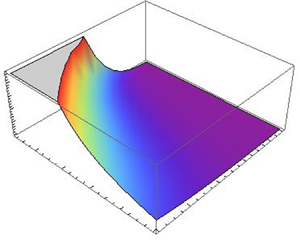Published online by Cambridge University Press: 27 July 2021

We consider a three-dimensional chemotaxis–convection–diffusion coupled system with the effect of surface tension at the deformed free surface. The novelty of this research is to explore the impact of surface tension on bioconvection. Our aim is to determine the nature of the instability at the onset of bioconvection in a chemotaxis–convection–diffusion system involving surface tension by performing a detailed linear stability analysis of steady-state cell and oxygen concentration distributions. The influence of the surface tension on the accumulated chemotaxis cells at the deformed free surface is studied analytically to illustrate its effect on the stability of the system. The Froude number,  ${{Fr_\tau }}$, and capillary number,
${{Fr_\tau }}$, and capillary number,  ${{Ca_\tau }}$, are two additional parameters introduced here. A detailed parametric study is undertaken to investigate the roles of the critical Rayleigh number,
${{Ca_\tau }}$, are two additional parameters introduced here. A detailed parametric study is undertaken to investigate the roles of the critical Rayleigh number,  ${{Ra_\tau }}_c$, as well as
${{Ra_\tau }}_c$, as well as  ${{Fr_\tau }}$ and
${{Fr_\tau }}$ and  ${{Ca_\tau }}$, in the chemotaxis system. Linear stability results revealed that an increasing value of
${{Ca_\tau }}$, in the chemotaxis system. Linear stability results revealed that an increasing value of  ${{Ra_\tau }}$ would stabilize the chemotaxis system. At a higher value of
${{Ra_\tau }}$ would stabilize the chemotaxis system. At a higher value of  ${{Fr_\tau }}$, the motion of the cells is faster towards the free surface, and as the surface tension force increases, less accumulated cells are found at the free surface. A cluster of the cells can be observed mostly at the trough rather than on the crest of the wave profile. While experimental results for the present model are not yet available, the results of the linear stability analysis provide useful information about the system's stability.
${{Fr_\tau }}$, the motion of the cells is faster towards the free surface, and as the surface tension force increases, less accumulated cells are found at the free surface. A cluster of the cells can be observed mostly at the trough rather than on the crest of the wave profile. While experimental results for the present model are not yet available, the results of the linear stability analysis provide useful information about the system's stability.